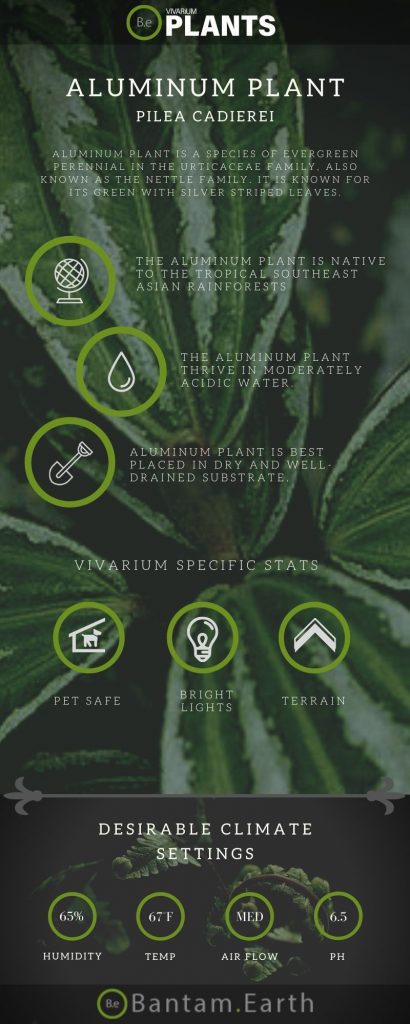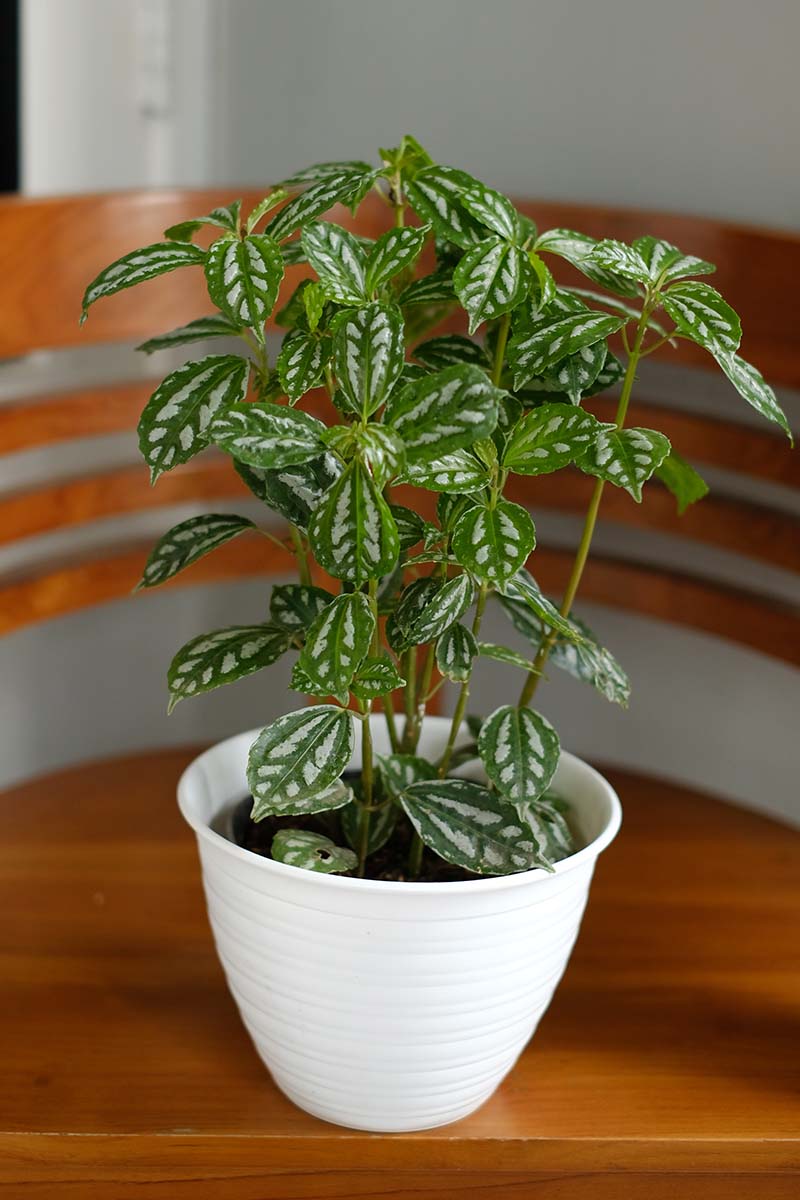Key Takeaways
- The Aluminum Plant, also known as Pilea cadierei, features striking silvery leaf patterns that add a decorative touch to any indoor space.
- This plant is native to Vietnam and thrives in warm, humid environments with bright, indirect light.
- Pilea cadierei is low-maintenance and ideal for beginners, requiring moderate watering and well-draining soil.
- Regular misting helps maintain the plant’s preferred humidity levels, preventing leaf spots and pest issues.
- Propagation is simple through stem cuttings, making it easy to expand your indoor garden.
The Aluminum “Watermelon” Plant (Pilea cadierei) is a popular indoor house plant known for its striking foliage and easy care requirements. Its leaves, which resemble the pattern of a watermelon, add a unique touch to any home decor. The plant thrives in well-draining soil and requires minimal maintenance, making it an ideal choice for both novice and experienced plant enthusiasts. Additionally, it can be propagated easily, allowing you to expand your collection or share with friends. If you notice black spots on the leaves, it may indicate a need for better air circulation or adjustments in watering habits. For those interested in creating a lush indoor environment, the Aluminum Plant is also suitable for terrariums and paludaria. When it comes to repotting, ensure you choose a pot that allows for adequate drainage to prevent root rot.
Aluminum “Watermelon” Plant Overview
The Aluminum Plant, scientifically known as Pilea cadierei, is a popular choice among indoor gardening enthusiasts. This charming plant is renowned for its lush green leaves adorned with metallic silver markings, resembling the texture of aluminum foil. These distinctive patterns not only make it a visual delight but also a conversation starter in any room.
“Pilea Cadierei “Aluminum Plant” Care …” from bantam.earth and used with no modifications.
Originating from the tropical regions of Vietnam, the Aluminum Plant brings a slice of the exotic into your home. It thrives best in conditions that mimic its native habitat, which means providing it with warmth, humidity, and the right amount of light is key to its health and vibrancy.
- Common Names: Aluminum Plant, Watermelon Pilea
- Botanical Name: Pilea cadierei
- Family: Urticaceae
- Type: Perennial
Unique Leaf Patterns
One of the most striking features of the Aluminum Plant is its leaves. The dark green foliage is beautifully contrasted with silvery-white markings, giving the plant its name. These patterns are reminiscent of the veins of a watermelon, which is why it’s also affectionately called the “Watermelon Pilea.”
These unique leaf patterns not only enhance the aesthetic appeal of the plant but also make it a standout addition to any indoor garden. Whether placed on a windowsill, a plant shelf, or a coffee table, Pilea cadierei is sure to catch the eye.
Native Habitat and Origins
The Aluminum Plant hails from the lush, tropical landscapes of Vietnam. It grows naturally under the canopy of rainforests, where it enjoys filtered sunlight and high humidity. Understanding its origins helps us replicate these conditions in our homes, ensuring the plant thrives.
Because it is accustomed to a warm and humid environment, the Aluminum Plant prefers temperatures between 60°F to 75°F (15°C to 24°C). This makes it an excellent indoor plant, as most homes maintain similar temperature ranges.
Benefits of Pilea cadierei
Beyond its beauty, the Aluminum Plant offers several benefits that make it a valuable addition to your indoor plant collection. Let’s explore some of these advantages.
Decorative Appeal
The Aluminum Plant is a fantastic choice for anyone looking to add a touch of elegance and color to their indoor spaces. Its striking leaves can enhance the visual appeal of your home, making it feel more lively and vibrant.
Whether you’re decorating a minimalist apartment or a cozy living room, the Pilea cadierei’s unique foliage fits seamlessly into various design styles. Its compact size also makes it suitable for small spaces, such as desks or shelves.
Air Purification Potential
While not as potent as some other houseplants, the Aluminum Plant does contribute to improving indoor air quality. It can help filter out certain pollutants, making the air in your home fresher and healthier.
Having a variety of houseplants, including Pilea cadierei, can create a more balanced and oxygen-rich environment, which is beneficial for both your physical and mental well-being.
Care Requirements for Healthy Growth
Ensuring the Aluminum Plant thrives involves understanding its specific care needs. While it’s relatively easy to maintain, providing the right conditions will help it flourish. For more detailed information, you can refer to this Aluminum Plant care guide.
Ideal Size and Growth Habit
Pilea cadierei typically grows to a height of 6 to 12 inches (15 to 30 cm), making it an excellent choice for indoor gardening. Its compact size allows it to fit comfortably in various spots around your home, from tabletops to windowsills.
This plant has a bushy growth habit, which means it tends to spread out rather than grow tall. Regular pruning can help maintain its shape and encourage denser foliage, enhancing its visual appeal.
Light and Temperature Preferences
The Aluminum Plant thrives best in bright, indirect light. Direct sunlight can scorch its delicate leaves, so it’s crucial to place it where it receives filtered light. A north or east-facing window is ideal, where the plant can enjoy the gentle morning sun without the harsh afternoon rays.
If you’re in a location with limited natural light, consider using a grow light to supplement its needs. Remember, maintaining consistent light exposure is key to preserving the plant’s vibrant leaf patterns.
As for temperature, Pilea cadierei prefers a warm environment. Keep the room temperature between 60°F to 75°F (15°C to 24°C). Avoid placing it near drafty windows or air conditioning vents, as sudden temperature changes can stress the plant.
Watering and Humidity Needs
The Aluminum Plant likes its soil to be consistently moist but not waterlogged. It’s best to water it when the top inch of soil feels dry to the touch. This ensures the roots have access to water without being submerged, which can lead to root rot.
Humidity is another crucial factor for the Aluminum Plant. It thrives in a humid environment, much like its native tropical habitat. If your home is dry, especially during winter months, consider using a humidifier or regularly misting the leaves to maintain humidity levels. This practice not only helps keep the leaves healthy but also prevents common issues like browning edges.
Soil and Propagation Techniques
Choosing the right soil is fundamental to the health of your Aluminum Plant. It requires a well-draining mix that retains some moisture without becoming soggy. A combination of peat moss, perlite, and regular potting soil in equal parts works wonderfully.
Besides that, ensuring the pot has drainage holes is essential to prevent water accumulation at the bottom. This simple step can save your plant from the detrimental effects of overwatering.
Propagation is an exciting way to expand your collection of Aluminum Plants. The most effective method is through stem cuttings, which is both simple and rewarding.
“To propagate, cut a healthy stem just below a node, remove the lower leaves, and place it in water or directly into soil. Roots typically develop within a few weeks, giving you a new plant to nurture.” – Indoor Gardening Enthusiast
Best Soil Mix for Aluminum Plant
The Aluminum Plant thrives in a soil mix that balances moisture retention and drainage. A well-prepared mix ensures the plant’s roots have access to both air and water, which is crucial for healthy growth.
Here’s a recommended soil mix:
- 1 part peat moss for moisture retention
- 1 part perlite for aeration and drainage
- 1 part potting soil for nutrients and structure
By mixing these components, you create an environment that mimics the plant’s natural habitat, supporting robust growth and vibrant foliage.
Regularly check the soil’s pH level as well, aiming for a slightly acidic to neutral range (6.0 to 7.0). This ensures optimal nutrient uptake and plant health.
Step-by-Step Propagation Methods
Propagating the Aluminum Plant is a straightforward process that can be done with a few simple steps. Here’s how you can do it:
1. Select a Healthy Stem: Choose a stem that is healthy and free from any signs of disease or damage. It should have several leaves and at least one node.
2. Make the Cut: Using clean, sharp scissors, cut the stem just below a node. This is where new roots will develop.
3. Prepare the Cutting: Remove the lower leaves to prevent them from rotting when placed in water or soil.
4. Rooting: Place the cutting in a glass of water or directly into moist soil. If using water, change it every few days to keep it fresh.
5. Transplanting: Once roots have formed, usually within a few weeks, transplant the new plant into a pot with the recommended soil mix.
Addressing Common Issues
Like any plant, Pilea cadierei can face a few challenges. Knowing how to address these issues promptly can keep your plant healthy and thriving.
Treating Black Spots on Leaves
Black spots on the leaves can indicate several issues, from fungal infections to improper watering. To treat this, first ensure you’re not overwatering. Allow the top inch of soil to dry out before watering again.
If the problem persists, consider using a fungicide to treat any potential fungal infection. Always remove affected leaves to prevent the spread of disease.
Identifying and Managing Pests
Common pests that affect the Aluminum Plant include spider mites and aphids. Regularly inspecting the leaves, especially the undersides, can help catch these pests early.
To manage pests, you can use insecticidal soap or neem oil. These natural remedies are effective in controlling infestations without harming the plant.
Aluminum Plants (Watermelon Pilea …” from gardenerspath.com and used with no modifications.
Indoor Cultivation and Repotting Tips
Growing the Aluminum Plant indoors requires some attention to detail, but with the right care, it can thrive beautifully. If you’re interested in creating a calming environment, consider exploring animal-assisted therapy benefits for a holistic approach to indoor gardening.
Setting Up Your Indoor Space: Choose a spot that offers bright, indirect light and maintains consistent temperature and humidity levels. For more tips, check out our pet-friendly furniture guide. Avoid areas with drafts or direct sunlight.
When and How to Repot: Repot your Aluminum Plant every one to two years, or when it becomes root-bound. Choose a pot that is one size larger than the current one, and refresh the soil with the recommended mix.
With these tips, your Aluminum Plant can continue to grow and add beauty to your home. Happy gardening!
Using Aluminum Plant in Terrariums and Paludaria
Incorporating the Aluminum Plant into terrariums or paludaria can create a stunning display that mimics its natural tropical environment. This setup not only enhances the plant’s beauty but also provides the humidity it craves.
When setting up a terrarium, ensure it is large enough to accommodate the plant’s growth. A closed terrarium is ideal for maintaining high humidity levels, which is beneficial for the Aluminum Plant.
Incorporating in Closed Environments
“A closed terrarium can be a perfect microenvironment for Pilea cadierei, as it helps maintain consistent humidity and temperature, creating conditions similar to its native habitat.” – Indoor Plant Enthusiast
To plant the Aluminum Plant in a terrarium, start by adding a layer of gravel or small stones for drainage. This is followed by a layer of activated charcoal to keep the environment fresh and prevent mold growth. Next, add a layer of potting soil that matches the plant’s needs.
Place the plant in the soil, ensuring it’s not too deep, and gently pat the soil around the roots. Water sparingly, as the closed environment will naturally retain moisture.
Monitoring Growth and Size Control
Regularly monitor the growth of your Aluminum Plant in a terrarium. Trim back any overgrown stems to maintain its shape and prevent it from outgrowing the space. Pruning not only helps in size control but also encourages bushier growth.
Keep an eye out for signs of over-humidity, such as mold or fungus, and adjust the environment accordingly by opening the terrarium for a short period to allow air exchange. For more ideas on maintaining your indoor environment, consider these tips for creating a comfortable space.
Frequently Asked Questions
Here are some common questions about caring for the Aluminum Plant, providing quick answers to help you keep your plant healthy and thriving. For those who might struggle with plant care, there are solutions for seniors unable to care for pets that can be adapted for plant care as well.
How often should I water my Aluminum Plant?
Water your Aluminum Plant when the top inch of soil feels dry. Typically, this means watering every week or so, but it can vary based on your home’s humidity and temperature.
What type of light does the plant prefer?
The Aluminum Plant prefers bright, indirect light. It can tolerate medium light conditions, but its leaf patterns may fade in low light. Avoid direct sunlight, as it can scorch the leaves.
Can I grow this plant outdoors?
While primarily an indoor plant, Pilea cadierei can be grown outdoors in a shaded area during warm months, as long as temperatures stay within its preferred range of 60°F to 75°F (15°C to 24°C). Bring it indoors when temperatures drop.
With these insights and tips, you’re well-equipped to care for your Aluminum Plant and enjoy its unique beauty in your home. Whether you’re a seasoned gardener or just starting, this plant offers both aesthetic appeal and ease of care, making it a delightful addition to any indoor garden. Happy planting!







